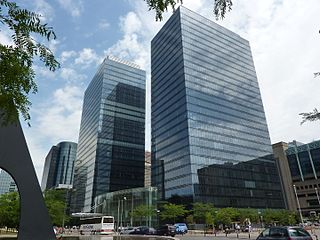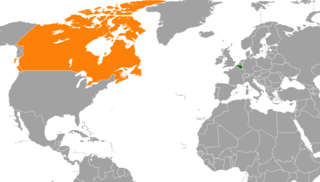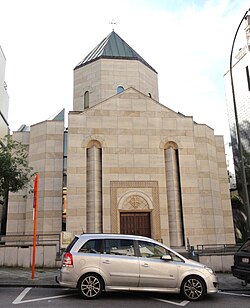
Transport in Belgium is facilitated with well-developed road, air, rail and water networks. The rail network has 2,950 km (1,830 mi) of electrified tracks. There are 118,414 km (73,579 mi) of roads, among which there are 1,747 km (1,086 mi) of motorways, 13,892 km (8,632 mi) of main roads and 102,775 km (63,861 mi) of other paved roads. There is also a well-developed urban rail network in Brussels, Antwerp, Ghent and Charleroi. The ports of Antwerp and Bruges-Zeebrugge are two of the biggest seaports in Europe. Brussels Airport is Belgium's biggest airport.

Flanders is the Dutch-speaking northern portion of Belgium and one of the communities, regions and language areas of Belgium. However, there are several overlapping definitions, including ones related to culture, language, politics, and history, and sometimes involving neighbouring countries. The demonym associated with Flanders is Fleming, while the corresponding adjective is Flemish, which can also refer to the collective of Dutch dialects spoken in that area, or more generally the Belgian variant of Standard Dutch. The official capital of Flanders is the City of Brussels, although the Brussels-Capital Region that includes it has an independent regional government. The powers of the government of Flanders consist, among others, of economic affairs in the Flemish Region and the community aspects of Flanders life in Brussels, such as Flemish culture and education.

For most of its history, what is now Belgium was either a part of a larger territory, such as the Carolingian Empire, or divided into a number of smaller states, prominent among them being the Duchy of Brabant, the County of Flanders, the Prince-Bishopric of Liège, the County of Namur, the County of Hainaut and the County of Luxembourg. Due to its strategic location as a country of contact between different cultures, Belgium has been called the "crossroads of Europe"; for the many armies fighting on its soil, it has also been called the "battlefield of Europe" or the "cockpit of Europe".

The economy of Belgium is a highly developed, high-income, mixed economy.
Tourism in Belgium is one of Belgium's industries. Its accessibility from elsewhere in Europe makes it a popular tourist destination. The tourist industry generates 2.8% of Belgium's gross domestic product and employs 3.3% of the working population. 6.7 million people travelled to Belgium in 2005. Two-thirds of them come from the larger nearby countries - France, The Netherlands, the United Kingdom, and Germany; there are also many tourists from Spain and Italy.

Hinduism is a minority religion in Belgium. According to the PEW 2014, Hinduism is also the fastest growing religion in Belgium. Attempts have been done by the Hindu Forum of Belgium (HFB) to make Hinduism an officially-recognized religion in Belgium.
Science and technology in Flanders, being the Flemish Community and more specifically the northern region of Belgium (Europe), is well developed with the presence of several universities and research institutes. These are strongly spread over all Flemish cities, from Kortrijk and Bruges in the Western side, over Ghent as a major university center alongside Antwerp, Brussels and Leuven to Hasselt and Diepenbeek in the Eastern side.

The history of the Jews in Antwerp, a major city in the modern country of Belgium, goes back at least eight hundred years. Jewish life was first recorded in the city in the High Middle Ages. While the Jewish population grew and waned over the centuries, by the beginning of World War II Antwerp had a thriving Jewish community comprising some 35,000, with many Jews connected to the city's diamond industry. The Nazi occupation of Antwerp from 1940 and The Holocaust decimated the city’s Jewish population. By the time of Antwerp's liberation in September 1944, the Jewish population had fallen to around 1,200.

Khajag Barsamian is an Armenian religious figure. He is the Pontifical Legate of the Western Europe and Representative of the Armenian Church to the Holy See. Formerly, he was the Primate of Diocese of Armenian Church of America (Eastern).

Belgium–Canada relations are those between the nations of Belgium and Canada. Both are close allies and members of NATO and Francophonie. Both have a stance of multilateralism. The two nations have official bilingualism, and similar federal government systems owing in part to language tensions in both. Both were actively involved in the war in Afghanistan under ISAF.
The development of urban centres in the Low Countries shows the process by which the Low Countries, a region in Western Europe, evolved from a highly rural outpost of the Roman Empire into the largest urbanised area north of the Alps by the 15th century CE. As such, this article covers the development of Dutch and Flemish cities beginning at the end of the migration period till the end of the Dutch Golden Age.

The history of Flanders concerns not only the modern Dutch-speaking part of Belgium, which is now called "Flanders", but also several neighbouring territories and populations. Its historical core territory was in western Belgium between the coast and the Scheldt river.

Antwerp is a city and a municipality in the Flemish Region of Belgium. It is the capital and largest city of Antwerp Province, and the third largest city in Belgium by area at 204.51 km2 (78.96 sq mi) after Tournai and Couvin. With a population of 536,079, it is the most populous municipality in Belgium, and with a metropolitan population of over 1,200,000 people, the country's second-largest metropolitan region after Brussels.

The Jains in Belgium are estimated to be around about 1,500 people.
The diamond industry in Armenia is a significant part of the country's manufacturing and exports. Armenia is a major supplier of diamond.
The following is a timeline of the history of the municipality of Antwerp, Belgium.

Bruges is the capital and largest city of the province of West Flanders in the Flemish Region of Belgium, in the northwest of the country. It is the sixth most populous city in the country.
Lebanese people, who come from various religious and ethnic groups, form a distinct community in Belgium as part of the global Lebanese diaspora. It was estimated in 2006 that there were 8,000 Belgians who identified as Lebanese in terms of origin or descent. More recent estimates put their numbers at only 3,500. The majority are Belgian citizens and live in major cities such as Brussels and Antwerp. In addition, it was reported the same year that 1,200 were living in Lebanon. They sometimes refer to themselves as Belgo-Libanais in French or Belgisch-Libanees in Dutch.

Assyrians in Belgium are Belgian citizens of Assyrian descent. Belgium's Assyrian diaspora is concentrated in the Flemish cities of Mechelen and Antwerp, although there are also significant numbers living in Liège and Brussels. The majority of the Assyrian diaspora living in Belgium are of Turkish descent, mostly from the towns of Bohtan (Beth-Qardu), Tur-Abdin and Hakkâri.
















